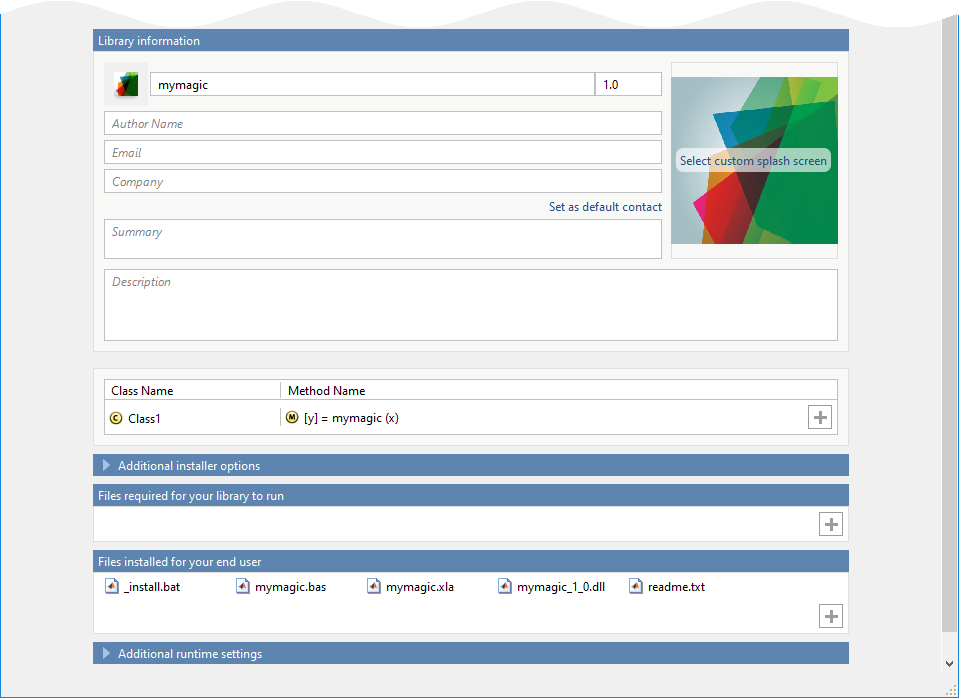Create Excel Add-In from MATLAB
Supported Platform: Windows® only.
This example shows how to generate a Microsoft® Excel® add-in from MATLAB®. You package the prewritten function that computes a magic square. MATLAB Compiler™ produces an installer that installs both the add-in and all the required dependencies on a target system. The target system does not require a licensed copy of MATLAB.
Create Function in MATLAB
In MATLAB, examine the MATLAB code that you want deployed as a standalone application. For this example,
open mymagic.m located in
matlabroot\toolbox\matlabxl\examples\xlmagic
function y = mymagic(x)
y = magic(x)
At the MATLAB command prompt, enter mymagic(5).
The output is:
17 24 1 8 15
23 5 7 14 16
4 6 13 20 22
10 12 19 21 3
11 18 25 2 9Create Excel Add-In Using Library Compiler App
On the MATLAB Apps tab, on the far right of the Apps section, click the arrow. In Application Deployment, click Library Compiler. In the MATLAB Compiler project window, click Excel Add-in.

Alternately, you can open the Library Compiler app by entering
libraryCompilerat the MATLAB prompt.In the Library Compiler app project window, specify the files of the MATLAB application that you want to deploy.
In the Exported Functions section of the toolstrip, click
 .
.In the Add Files window, browse to the example folder, and select the function you want to package. Click Open.
The function is added to the list of exported function files. Repeat this step to package multiple files in the same application.
In the Packaging Options section of the toolstrip, decide whether to include the MATLAB Runtime installer in the generated application by selecting one of the options:
Runtime downloaded from web — Generate an installer that downloads the MATLAB Runtime and installs it along with the deployed MATLAB application. You can specify the filename of the installer.
Runtime included in package — Generate an application that includes the MATLAB Runtime installer. You can specify the filename of the installer.
Note
The first time you select this option, you are prompted to download the MATLAB Runtime installer.
Verify that the function defined in
mymagic.mis mapped intoClass1.
Customize the packaged application and its appearance:
Library information — Editable information about the deployed application. The generated installer uses this information to populate the installed application metadata. See Customize the Installer.
Additional installer options — Edit the default installation path for the generated installer and selecting custom logo. See Change the Installation Path .
Files required for your library to run — Additional files required by the generated application to run. These files are included in the generated application installer. See Manage Required Files in Compiler Project.
Files installed for your end user — Files that are installed with your application. These files include:
Generated
readme.txtGenerated executable for the target platform
Additional runtime settings — Platform-specific options for controlling the generated executable. See Additional Runtime Settings.

Package the Application
To generate the packaged application, click Package.
In the Save Project dialog box, specify the location to save the project.
In the Package dialog box, verify that Open output folder when process completes is selected.
When the packaging process is complete, examine the generated output.
Three folders are generated in the target folder location:
for_redistribution,for_redistribution_files_only, andfor_testing.For more information about the files generated in these folders, see Files Generated After Packaging MATLAB Functions.
PackagingLog.txt— Log file generated by MATLAB Compiler.